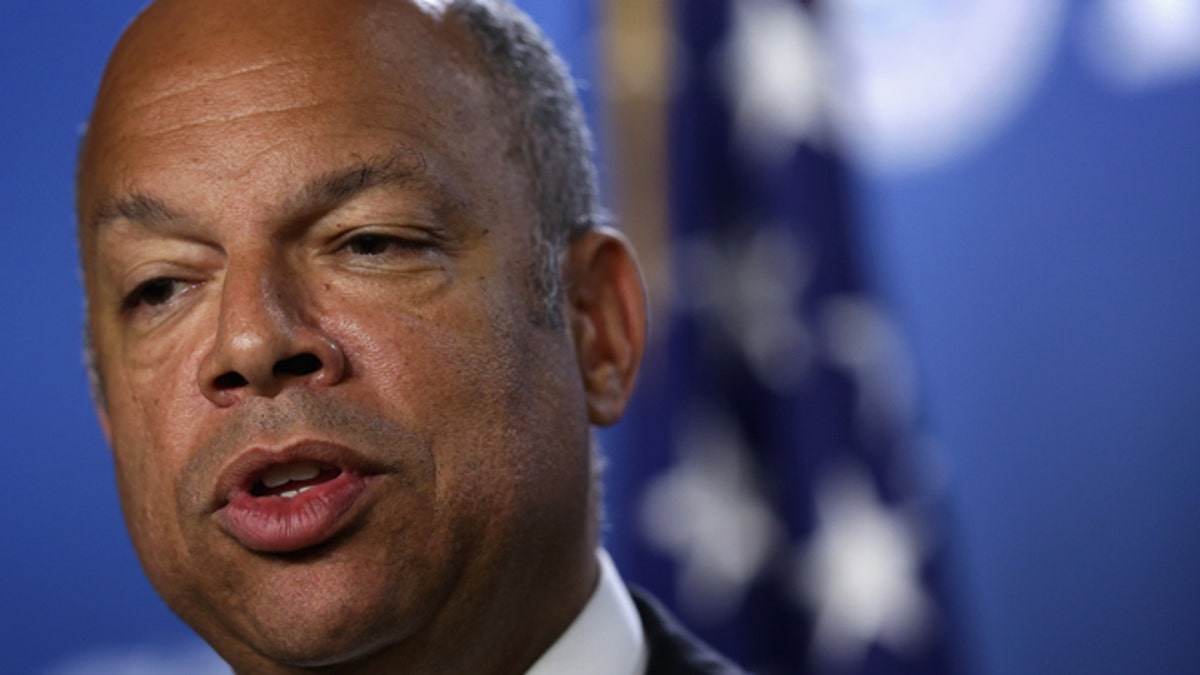
WASHINGTON, DC - JULY 22: U.S. Homeland Security Secretary Jeh Johnson speaks during a news conference on human smuggling along the southwest border July 22, 2014 in Washington, DC. Secretary Johnson spoke on Operation Coyote, a 90-day surge operation which is currently conducted in the Texas Rio Grande Valley to target human smuggling operations. (Photo by Alex Wong/Getty Images) (2014 Getty Images)
United States Department of Homeland Security chief Jeh Johnson announced a new angle this week on the federal government’s attempt to stem the flow of immigrants flooding the U.S.-Mexico border: The agency, he said, has decided to follow the money.
“We are interdicting the flow of money that goes to these [human] smuggling operations,” Johnson said.
In late June, DHS and other federal money-laundering agents who previously had been focusing on the operations of violent drug cartels are now targeting the “funnel accounts” that smuggling rings use to collect money from immigrants and their families.
“The agency is starting to put more energy toward dismantling these groups than they had in the past,” Alonzo Peña, former deputy director of Immigration and Customs Enforcement (ICE), told the Los Angeles Times recently.
DHS reassigned 60 investigators and support personnel to the Rio Grande Valley and have asked for an additional $109 million as part of the $3.7 billion White House request to further expand the agency’s anti-smuggling operations.
A senior federal law enforcement official told the Times that drug cartels don’t directly control the human-trafficking in the region but do get a cut of their business for passing through cartel-controlled turf.
“Any activity they can make a buck from, they will seize that opportunity,” the official said.
While the amount of money involved is much less than with drug cartels, it isn’t exactly chump change, either. The United Nations estimates that human trafficking generates about $32 billion a year.
A recent report by the Association of Certified Financial Crime Specialists (ACFCS) placed human trafficking as the third-most profitable organized crime behind drug trafficking and the sale of pirated goods.
“Financing is the lifeblood of these trafficking organizations,” Jack Williams, a law professor at the Georgia State University and former consultant to the U.S. government on organized crime, told the ACFCS. “If you can turn off that spigot, that organization will crumble from the inside.”
Adam Isacson, senior associate at the D.C.-based Washington Office on Latin America, told the newspaper that targeting the networks' funds "could certainly disrupt some of the traffic."
He also pointed out that if the feds are able to seize enough of their profits, it would force the groups to charge higher fees, which would price out many potential migrants.
Since launching a three-month initiative on June 23, federal authorities have arrested 192 people involved on the financial side of smuggling operations and seized around $625,000 in profits from 288 bank accounts, according to the Arizona Republic.
The way human-smuggling networks generally work is that coyotes typically charge between $5,000 and $12,000 to smuggle a child from Central America across the U.S.-Mexico border. The networks pay associates to open accounts at banks with branches across the United States.
Relatives of the undocumented immigrants wire cash into the accounts, which are then closed out by the smugglers or their agents.
This makes financial activities difficult to detect, because the transactions are often for amounts below the $10,000 level that triggers automatic reporting to banking regulators.
In March, Joel Mazariegos Soto, 29, a Guatemalan immigrant working at a farm in New York state, was sentenced to five years in prison after pleading guilty to having operated a funnel account that collected at least $70,000 for a human-smuggling organization, according to ICE officials.
Scott Brown, the deputy special agent in charge of investigations for the Phoenix office of ICE, told the Arizona Republic about the human-trafficking business, "It’s exploitative, and it's profit-driven. If we can take that profit out, we take the incentive to commit that crime out.”
Follow us on twitter.com/foxnewslatino
Like us at facebook.com/foxnewslatino
























